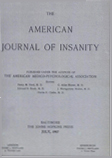THE INTERNAL ENVIRONMENT AND BEHAVIOR
Abstract
1. Hypoglycemia leads to a general decrease in cortical activity, measurable by a delay in and an inaccuracy of mental functions. This condition is accompanied by typical changes in the electroencephalogram and in the electrocorticogram which indicate a diminution in the oxidative state of the cortex (Hoagland).
2. Insulin hypoglycemia produces a state of increased excitability of sympathetic centers. This is shown by an increased blood pressure response to anoxia and to CO2 at low blood sugar levels. It is further indicated by the increased blood pressure rise on raised intracranial pressure during the hypoglycemic state. Since the increased response to CO2 and to increased intracranial pressure persists after elimination of the chemoreceptors of the carotid sinus area and of the arch of the aorta, it follows that low blood sugar increases sympathetic responses not only in response to reflex stimuli but also to stimuli acting directly on the centers. Another indication of increased excitability of the sympathetico-adrenal system in hypoglycemia is the fact that the blood sugar rise observed during a brief period of anoxia is more marked in the hypoglycemic animal than it is at a normal blood sugar level.
3. This increased sympathetic excitability is linked up with a sympathetico-adrenal discharge occurring during hypoglycemia. To the well known signs of such a discharge is added the fact that the CO2-tension of the arterial blood and of the alveolar air decreases in hypoglycemia. If, however, coma supervenes, the CO2-tension in the alveolar air rises. This may be taken as an indication of a generally decreased excitability of the brain.
4. The increased sympathetico-adrenal discharge occurring in insulin hypoglycemia tends to lead to a restoration of normal conditions (homeostatis) not only by the glycogenolytic action of adrenalin on the liver but also by its depressing action on the sympathetic centers via the carotid sinus.
5.If hypoglycemia and anoxia are combined for several hours, a condition results in which homeostatic regulations break down by the failure of adrenalin to produce glycogenolysis. Under these conditions the excitability of the brain is altered since the animals do not respond with convulsions to extreme degrees of hypoglycemia.
6. The excitability of the autonomic system is not altered by an increased blood sugar level resulting from the injection of glucose. However, a rise of blood sugar resulting from reflex stimulation of autonomic centers by painful stimuli or by injection of metrazol or adrenalin is accompanied by a generally increased excitability and a fall in the CO2-tensions of the arterial blood.
Access content
To read the fulltext, please use one of the options below to sign in or purchase access.- Personal login
- Institutional Login
- Sign in via OpenAthens
- Register for access
-
Please login/register if you wish to pair your device and check access availability.
Not a subscriber?
PsychiatryOnline subscription options offer access to the DSM-5 library, books, journals, CME, and patient resources. This all-in-one virtual library provides psychiatrists and mental health professionals with key resources for diagnosis, treatment, research, and professional development.
Need more help? PsychiatryOnline Customer Service may be reached by emailing [email protected] or by calling 800-368-5777 (in the U.S.) or 703-907-7322 (outside the U.S.).



